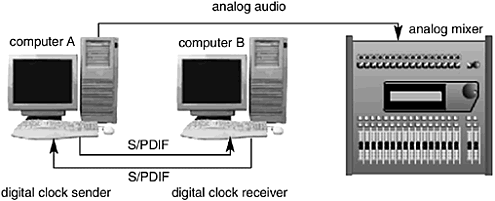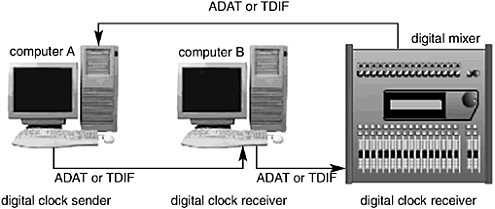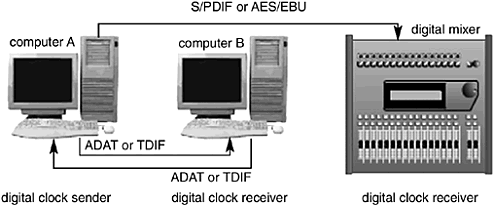VST System Link
| [ LiB ] |
VST System Link
It seems that we never have enough power in one computer to do all that we want to do. Well, Steinberg understands this and developed a protocol called VST System Link , which connects two or more computers together using a digital audio connection as the link between these two computers. After your computers are hooked up together, the VST System Link, makes it possible to run two or more VST System Link compatible host applications in perfect digital audio sync with each other. It does this without any network cards, hubs, or other type of connection.
After the computers are linked, you can activate the system link and use VSTi in one computer and control them using a keyboard hooked up to the second computer. You can also have audio tracks in two different projects on two different computers playing in complete sync. This means that you can split the tracks of your song into two projects, processing some tracks here, other tracks there, sharing the workload between two computers even if the computers are not in the same room as you are. If you don't want to split up your audio tracks, you can still run all your effects on one computer and monitor the result in the other. Using this system, you could run Cubase with Nuendo or V-Stack, or on a Mac and a PC, for example. V-Stack is a System Link host, but without the Cubase or Nuendo tracks. In other words, you can load VSTi, but you can't record any events in it. You can visit Steinberg's Web site for more information.
About System Link
VST System Link uses a single bit of the digital audio stream as a carrier for transport and synchronization information. It can also use other bits of the digital audio stream for MIDI information. Several computers can be linked in a daisy-chain configurationeach one passing on the accumulated information to the next via standard digital audio cables, with routing to the various systems controlled by a master (sender) software running on the first computer in the chain.
To run a VST System Link, you need the following items:
-
Two or more computers. All computers must have an ASIO 2.0 compatible sound card.
-
A host application (such as Cubase SX, SL, SE, V-Stack, Nuendo, or Cubase VST 5.2 System Link version) running on each computer.
-
All sound cards must have one of the following digital audio connectors: SPDIF, ADAT, TDIF or AES/EBU. This said, your sound card might have an ADAT connector, but it might not work with System Link. If you are investigating potential sound cards, make sure to find out if your sound card has been tested successfully with System Link before purchasing it for this purpose. You can find information on the sound card's manufacturer Web site or at the Steinberg Web site or forums (http://forum.cubase.net).
-
At least one digital cable for each computer in your VST System Link network.
Linking Computers
In its simplest form, you can connect two computers by using a simple S/PDIF or AES/EBU digital connection, as shown in Figure 14.2. In this scenario, Computer A's digital Out goes into Computer B's digital In and vice versa. If you don't have a digital mixer or even an analog mixer, you can simply send the analog output of Computer A to your monitoring system. Because the system link only uses one bit in your digital connection, you can still use the other 15 bits (19 or 23, depending on the digital word length available in your sound card) to transmit digital audio from Computer B to Computer A. Therefore, you would be mixing both the content of Computer A & B inside Computer A, sending the final mix to a pair of control room monitors .
Figure 14.2. Setting up a system link between two computers using S/PDIF or EBU.

It is important, as in any digital linkup, that one of the two computers be the digital clock sender (master clock) and the other, the digital clock receiver (slaved clock).
In Figure 14.3, we've replaced the analog mixer with a digital one, allowing us to connect digitally to the mixer and use this mixer to forward any instruments you might want to record. As with the previous setup, Computer A is the digital clock sender and the two other devices are receivers.
Figure 14.3. Setting up a system link between two computers and a digital mixer using any digital connection.

However, you could set the digital mixer as a digital clock sender and have the two computers receiving. It all depends on how your studio is set up. The figure displays an ADAT connection between each component in the linked network. This is probably the most convenient way of doing it, giving you eight digital channels that you can patch anywhere you want, but you could also do this with a S/PDIF or an AES/EBU connection.
This type of setup is pretty simple as well, but it also has some limitations. Because the ADAT carries the audio information from A to B, you will be using Computer B to monitor or mix. Computer A, on the other hand, is receiving the digital mixer's outputs through its ADAT connection. You, therefore, have to configure your setup to properly monitor and record events from Computer B, or use Computer A as your main station, using the digital mixer's ADAT outputs to monitor Computer B.
Figure 14.4's setup is similar to the one provided in the previous figure; however, in this case, an S/PDIF (this could be another format as well) feeds the digital input of the digital mixer, allowing you to monitor or control from Computer A, and then to the digital mixer to monitor the output in speakers . You could also draw an S/PDIF connection from the mixer's digital output to Computer A's digital input. As you can see, connecting hardware using System Link is quite easy. Now, let's look at how it all works inside Cubase.
Figure 14.4. Setting up a system link between two computers and a digital mixer by using two digital connections.

Latency Issues with System Link
As you saw earlier in this book, latency is the delay that happens between the processing stage and the monitoring stagefor example, the delay between the moment you press a note on your keyboard and the time it takes for a VSTi to play that note. With ASIO driver sound cards and Cubase, this can be kept to a minimum, hopefully below 10 or 12 milliseconds. However, when linking computers together, the latency is the total amount of latency caused by all computers. So, if you have 10 milliseconds of latency on both, your total latency when linking computers is approximately 20 milliseconds . Note that latency does not affect the synchronization of events with the rest of your events because Cubase's technology compensates for this latency. Because the more latency you have, the more delay you hear between the action and the result, the harder it is for you to focus on the task at hand when recording events through a linked system with a high latency time.
You can generally adjust the latency time of a sound card by changing its DMA buffer size, as mentioned earlier in this book. If you are not sure how to change these values, consult the driver documentation for your hardware device (sound card).
| [ LiB ] |